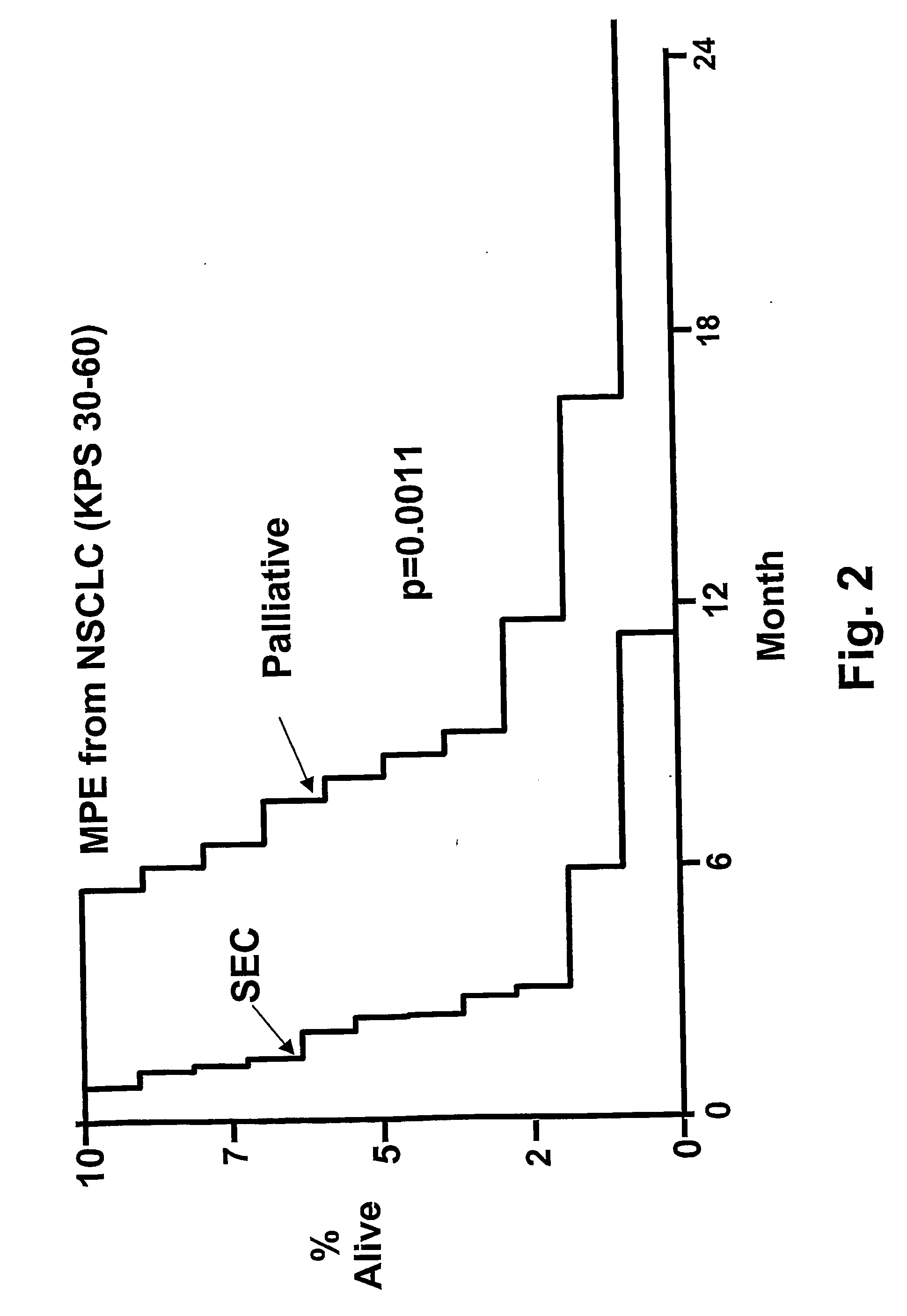Intrathecal and intratumoral superantigens to treat malignant disease
a superantigen and intra-tumor technology, applied in the field of immunology and medicine, can solve the problems that prior art does not disclose the administration of sag intrathecally or more specifically, intra-pleurally, and achieve the effects of enhancing the proliferative response of t cells, promoting coagulation in the tumor vasculature, and enhancing the effectiveness and specificity of sag
- Summary
- Abstract
- Description
- Claims
- Application Information
AI Technical Summary
Benefits of technology
Problems solved by technology
Method used
Image
Examples
example 1
Intrathecal (Intrapleural) Injection of SEC in Patients with Malignant Pleural Effusions
Methods
[0268] Patients: From February 1999 to October 2002, 14 consecutive patients with NSCLC and MPE were evaluated. Twelve were considered to be evaluable for response and ten for survival. Patins were required to have NSCLC with at least a 350 ml effusion. Chemotherapy, radiation and all other biological response modifying agents with antitumor activities were discontinued at least a month before starting treatment. Patients that had been treated with prior intrapleural chemotherapy, pleurodesis, lobectomy or pneumonectomy on the affected side were excluded. Pleural effusions were diagnosed by chest radiographs, chest CT and ultrasonography. The diagnosis of MPE was established by positive pleural fluid cytology. In two patients, cytology of pleural fluid examined 24 hours after treatment showed evidence of tumor killing.
[0269] Before each course of treatment, the patients received a comp...
example 2
Treatment of Lung Adenocarcinoma by Intratumoral Injection of SEA Followed by Intratumoral Chemotherapy
Patient and Treatment Plan
[0291] The patient is a 75 year old man with a large adenocarcinoma in the left midlung field.
[0292] He received intratumoral administration of SEC (5 ng) once weekly for 7 weeks. During weeks 8-11, the patient received weekly intratumoral injections of SEA (5 ng) together with cisplatin (10 mg). Chest x-rays were done before treatment and 1 week after the conclusion of the last dose of intratumoral SEC / cisplatin.
[0293] Criteria for response are as set forth by the International Union Against Cancer and are given in more detail below. Briefly, a complete response is defined as no measurable disease. A partial response is defined as a 50% reduction of the bidirectional diameter of measurable tumor.
[0294] Results: One week after concluding the course of intratumoral SEAC followed by intratumoral SEA+cisplatin, the patient's chest x-ray and CT scan show...
example 3
Clinical Trial of Intratumoral SAg and Low Dose Chemotherapy in Humans Patients
[0296] All patients treated have histologically confirmed malignant masses confirmed by biopsy or cytology are entered. Malignant diseases including carcinomas, sarcomas, melanomas, gliomas neuroblastomas, lymphomas and leukemia. The malignant disease has failed to respond or is advancing despite conventional therapy. Patients in all stages of malignant disease involving any organ system are included. Staging describes both tumor and host, including organ of origin of the tumor, histologic type, histologic grade, extent of tumor size, site of metastases and functional status of the patient. For a general classification includes the known ranges of Stage 1 (localized disease) to Stage 4 (widespread metastases), see Abraham J et al., Bethesda Handbook of Clinical Oncology, Lippincott, Williams & Wilkins, Philadelphia, Pa., 2001. Patient history is obtained and physical examination performed along with conv...
PUM
| Property | Measurement | Unit |
|---|---|---|
| Fraction | aaaaa | aaaaa |
| Fraction | aaaaa | aaaaa |
| Temperature | aaaaa | aaaaa |
Abstract
Description
Claims
Application Information
 Login to View More
Login to View More - R&D
- Intellectual Property
- Life Sciences
- Materials
- Tech Scout
- Unparalleled Data Quality
- Higher Quality Content
- 60% Fewer Hallucinations
Browse by: Latest US Patents, China's latest patents, Technical Efficacy Thesaurus, Application Domain, Technology Topic, Popular Technical Reports.
© 2025 PatSnap. All rights reserved.Legal|Privacy policy|Modern Slavery Act Transparency Statement|Sitemap|About US| Contact US: help@patsnap.com



